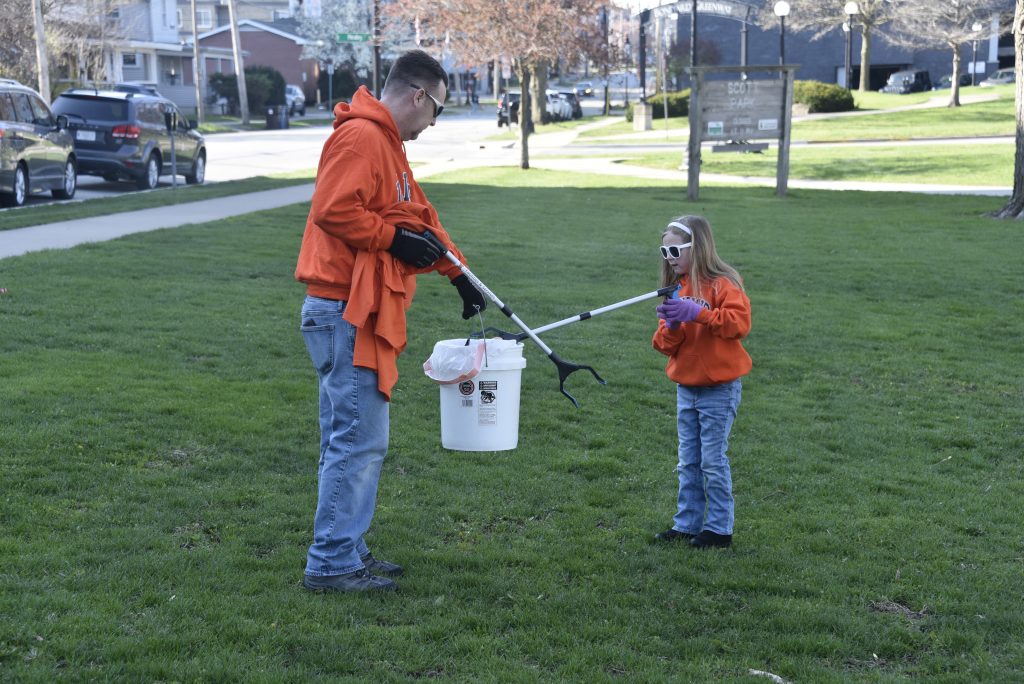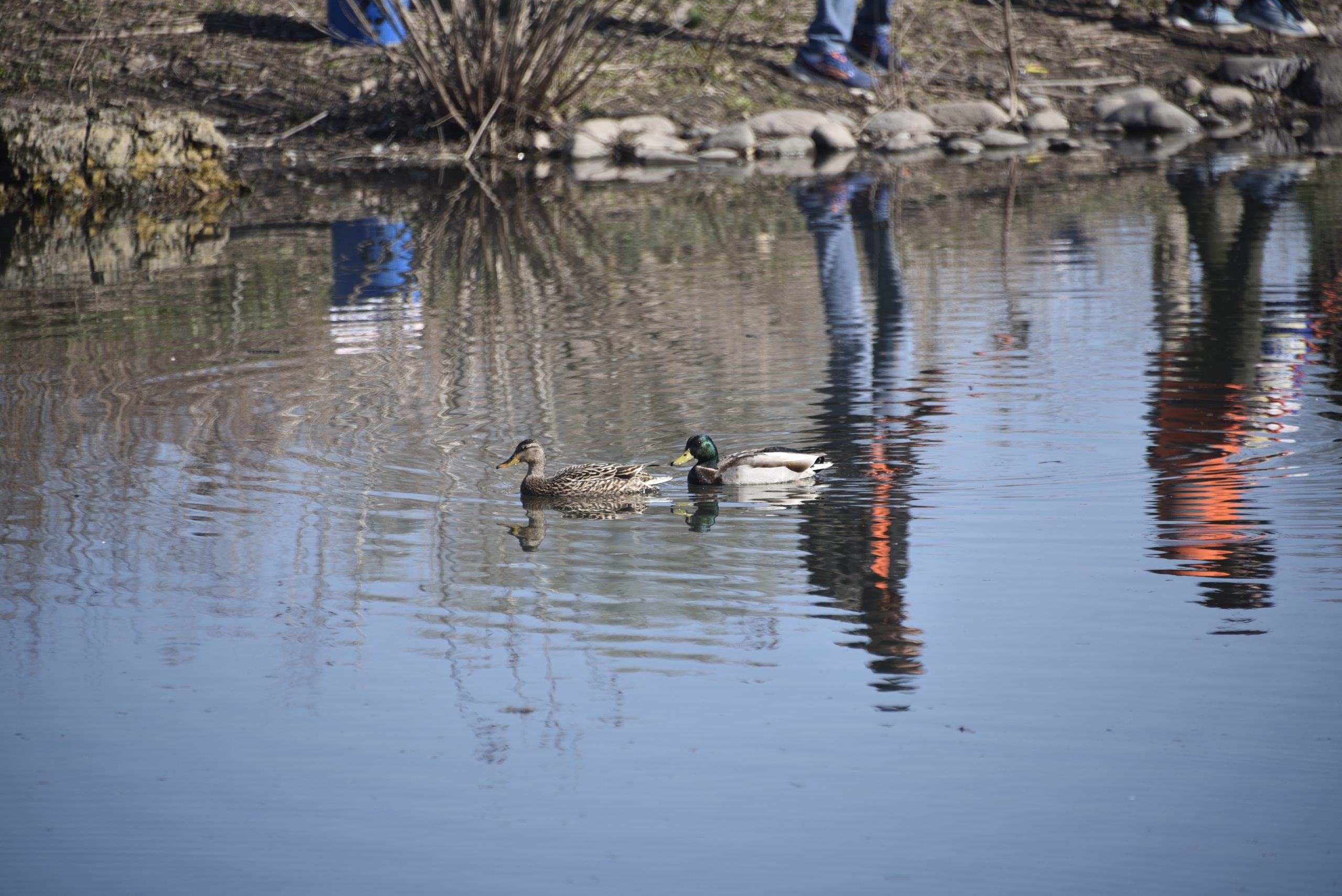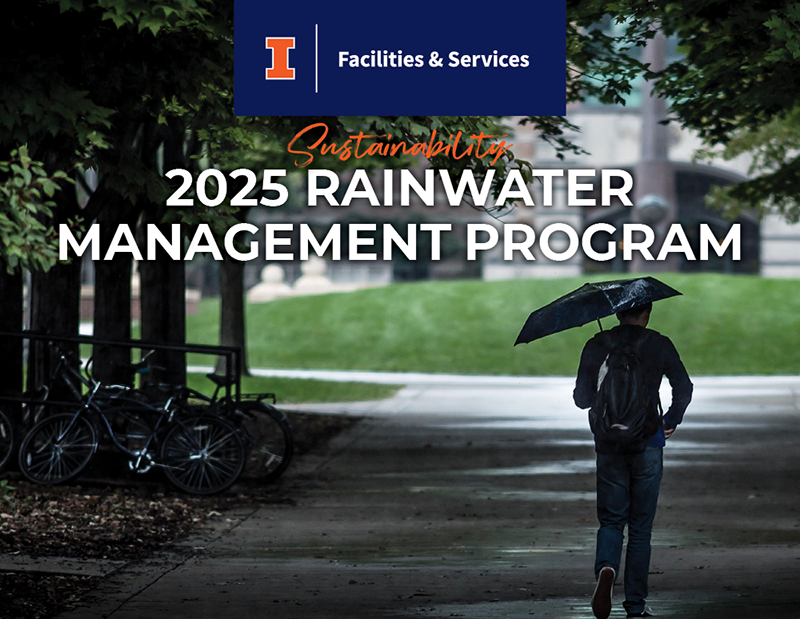Stormwater Management

Emergency Spill Response
If a release is LIFE THREATENING, dial 911. If a release is NON-LIFE THREATENING, call the Service Office 217-333-0340.
More: https://go.fs.illinois.edu/SpillResponse
Stormwater is important on our campus
The University of Illinois Urbana-Champaign’s Rainwater Management Program (RMP)* showcases a future vision for the campus that emphasizes the importance of stormwater retention and replenishment. The goal is to transition from the traditional viewpoint of stormwater runoff as a maintenance issue to one that envisions rainwater as an asset to preserve, harness, and celebrate.
Permit Requirements
The Stormwater Management Program meets the requirements of the University’s permit with the Illinois EPA. Called a Municipal Separate Storm Sewer (MS4) Permit, it allows the University to discharge stormwater into its receiving streams.
General Stormwater Permit for Small Municipal Separate Storm Sewer Systems (MS4)
Stormwater Management Program BMPs
The 58 best management practices (BMPs) include initiatives that educate students, staff, and faculty about stormwater impacts, detect and eliminate illicit discharges, control stormwater runoff from construction sites during and after construction, and prevent pollution from facility operations.
Public Education and Outreach on Stormwater Impacts
BMP A.1.1 Stormwater fact sheets, brochures and posters
BMP A.1.2 Press release
BMP A.1.3 Stormwater website
BMP A.2.1 Information presentation or booth
BMP A.3.1 Social media, radio, television and/or internet public service announcements
BMP A.4.1 Biennial Green Infrastructure Conference
Public Involvement/Participation
BMP B.1.1 Campus and student community participation in storm water initiatives
BMP B.2.1 Volunteer illicit discharge training
BMP B.3.1 Stakeholder meeting
BMP B.4.1 Provide opportunity for public input on the Storm Water Program including environmental justice information
BMP B.6.1 Program Involvement with CCSP MS4 Committee (City of Urbana, City of Champaign, Village of Savoy, Champaign County and University of Illinois)
BMP B.6.2 Identify any watershed work groups within jurisdiction to enhance stormwater program
BMP B.7.1 Campus clean-up event
Illicit Discharge Detection and Elimination
BMP C.1.1 GIS Storm Sewer System Map
BMP C.2.1 Prohibit illegal discharges to storm sewer system
BMP C.3.1 Investigate priority areas for illicit discharges by following SOP/Building Review Process and correct illicit connections if needed
BMP C.3.2 Maintain septic system inventory
BMP C.3.3 Provide educational presentations or information to commercial/industrial groups to recognize and correct illicit detections
BMP C.6.1 Annual report to Urbana-Champaign Sanitary District if illicit connections repaired and connected to sanitary sewer
BMP C.7.1 Visual inspection of outfalls during dry weather
BMP C.10.1 Construction Facility Standard requiring new storm sewer inlets have storm water protection warning
BMP C.10.2 Publicize spill reporting procedures
Construction Site Stormwater Runoff Control
BMP D.2.1 Pre-construction briefings/reviews for sites one acre or greater soil disturbance
BMP D.2.2 Facilities & Services inspector group compliance monitoring at construction sites
BMP D.2.3 Maintain Facility Standard to require AE to prepare SWPPP for projects disturbing one acre or more
BMP D.2.4 Construction Operator Education for program compliance and appropriate selection, installation, implementation, and maintenance of storm water controls.
BMP D.4.1 Review Stormwater Pollution Prevention Plans (SWPPP) and erosion control plans
BMP D.4.2 Maintain an inventory list for all projects that are one acre or greater soil disturbance
BMP D.5.1 Construction site spill or illegal discharge procedures on Safety & Compliance website
BMP D.6.1 Enforce contractor requirements associated with NPDES ILR10 permit, SWPPP and the Erosion and Sedimentation Control Enforcement Facility Standard
BMP D.6.2 Conduct construction site inspections as required by qualified personnel: Contractor construction site inspections weekly and after 0.5″ rain; Permittee prior and during construction inspections.
BMP D.6.3 Maintain and implement procedures for handling reports of non-compliance
Post Construction Stormwater Management in New Development and Redevelopment
BMP E.2.1 Update storm water management policies as needed
BMP E.3.1 Evaluate feasibility of green infrastructure and low impact design for new or redeveloped properties taking into account climate change
BMP E.3.2 Annual training for MS4 employees who manage or are directly involved in the routine maintenance, repair, or replacement of public surfaces in current green infrastructure or low impact design to decrease pollutants
BMP E.4.1 Plant preservation review during pre-construction site developments
BMP E.5.1 Contractor qualified personnel conduct construction site inspections weekly and after 0.5″ rain. Permittee conduct prior and during construction inspections.
BMP E.6.1 Inspect and maintain retention basin
BMP E.7.1 Project Utility Program Statements low impact design elements
Pollution Prevention/Good Housekeeping for Municipal Operations
BMP F.1.1 Abbott Power Plant Facility Response Plan
BMP F.1.2 Implement SPCC Plans
BMP F.1.3 Laboratory and Hazardous Material Training
BMP F.1.4 Pesticide application training
BMP F.1.5 Employee and contractor training to prevent and reduce storm water pollution
BMP F.1.6 Transportation salt/sand use and under cover storage training
BMP F.2.1 Maintenance and repair programs for campus car, truck and heavy equipment pools
BMP F.3.1 Storm sewer system and catch basin inspection and cleaning program/schedule
BMP F.3.2 Sanitary sewer system and catch basin inspection and cleaning program/schedule
BMP F.3.3 Municipal Facilities and Stormwater Control inventory
BMP F.3.4 Municipal Facilities and Stormwater Control map that includes facilities, outfalls and receiving waters
BMP F.3.5 Municipal Facilities and Stormwater Control quarterly visual inspections (facility & stormwater discharge)
BMP F.4.1 Hazardous waste management and pickup program
BMP F.4.2 Recycling service at the Waste Transfer and Material Recovery Facility under cover to avoid contact with storm water
BMP F.6.1 Direct vehicle washing to sanitary sewer
BMP F.6.2 Pesticide Use Policy and landscape material reduction activities
BMP F.6.3 Street sweeping
BMP F.6.4 Parking deck sweeping and triple basin inspections
BMP F.6.5 Emergency response contractor continuing purchase order and spill response procedures
Collaboration
The University collaborates with neighboring communities that also have MS4 permits by sharing information and resources to best comply with requirements. The MS4 Champaign County Stormwater Partnership includes practitioners from the University, the City of Champaign, City of Urbana, Village of Savoy, and Champaign County. Committee activities include hosting stormwater conferences and sponsoring clean up events.
Champaign County Stormwater Partnership
In the Media
Audio PSA: Clean streams are for everyone.
Audio PSA: Take it to the carwash.
Storm Drains Get Artistic Makeover News-Gazette 8-17-13
The University completes and submits an annual written report to the Illinois EPA. The reports summarize the University’s activities to comply with the Stormwater Management Program. Program years are from April 1 to March 31. Please click below to see the reports.
Construction sites must comply with Federal, State, and University stormwater requirements. University requirements are found in the University’s Facility Standards. Below are resources for compliance with the Standards.
RESOURCES:
Template: SWPPP
Forms: Incidence of Noncompliance, Inspection, Change in SWPPP, Dewatering Inspection Report Template
Brochure: Pollution Prevention
Websites: Illinois Urban Manual
International Erosion Control Association
The University’s Stormwater Management Program includes Public Education activities that inform campus and community about keeping our receiving streams clean.
BONEYARD CREEK COMMUNITY DAY
2026 Boneyard Creek Community Day coming April 18, 2026. (Rain date: May 2, 2026)



The Boneyard Creek Community Day is an annual volunteer event that helps minimize pollution, improve water quality, and restore the beauty of the Boneyard Creek and other local waterways. Volunteers remove trash and non-native plants, and mark storm drains.
Registration information and more event details are available at www.boneyardcreek.org.
See more about Boneyard Creek Community Day here: https://fs.illinois.edu/News/boneyard-creek-community-day
ILLINOIS GREEN INFRASTRUCTURE & EROSION CONTROL CONFERENCE
Thank you for coming to the 2025 Illinois Green Infrastructure & Erosion Control Conference! We look forward to another in 2027!
For more information, and past events: https://www.ccstormwater.org.
For more information, visit: https://fs.illinois.edu/News/illinois-green-infrastructure-erosion-control-conference.
POSTERS
Feel free to download these outreach posters.
Stormwater Tool Box Talks
- Storm Water Permits
- Winter Storm Water Practices
- Stormwater Spill Response
- Soil Erosion Sedimentation Control
- Dewatering Practices
For information on climate change and stormwater, visit the following websites:
Climate Change | US EPA
Water as Climate Change Solution | US EPA
For information on environmental justice and stormwater, visit the following website:
Environmental Justice | IL EPA
Additional Resources
Do you know where your stormwater goes? On the University of Illinois Urbana-Champaign campus, there are two answers: Boneyard Creek and a tributary to the Embarras River. The goal of the Stormwater Management Program is to improve the water quality the campus sends to these receiving streams.
RELATED LINKS
EPA: Healthy Watersheds Initiative
Boneyard Creek and Embarras River
Green Stormwater Infrastructure helps improve stormwater quality and decrease flooding by delaying peak flows and filtering pollutants. In addition to these benefits, they also can increase landscape aesthetics. Green Stormwater Infrastructure can be found throughout the Urbana-Champaign campus. These projects include green roofs, rain gardens/infiltration basins, detention ponds, rain barrels, permeable asphalt/concrete/pavers and underground retention basins.
Campus Green Stormwater Infrastructure highlights:
Yeh Student Center Green Roof
Business Instructional Facility Green Roof
Red Oak Rain Garden
Japan House and Arboretum Bicycle Parking Permeable Pavers
See more projects here.
GREEN INFRASTRUCTURE & EROSION CONTROL CONFERENCE
Thank you for coming to the 2025 Illinois Green Infrastructure & Erosion Control Conference! We look forward to another in 2027!
For more information, and past events: https://www.ccstormwater.org.
For more information, visit: https://fs.illinois.edu/News/illinois-green-infrastructure-erosion-control-conference.
The CCSP a collaborative effort of local government entities in Champaign County, Illinois consisting of Champaign County, City of Champaign, City of Urbana, University of Illinois Urbana-Champaign, and the Village of Savoy. The partners share common resources and efforts to develop a regional consistency in fulfilling the requirements of their Municipal Separate Storm Sewer System (MS4) permits.
For information regarding the program, registration, presenters/presentations, live recordings of past events: https://www.ccstormwater.org.
RED OAK RAIN GARDEN
The Red Oak Rain Garden (RORG) is a sustainable landscape that celebrates rain, invigorates the campus and community education experience, and promotes well-being. The RORG is a green space located between Allen Hall and the McKinley Health Center.
It was the first rain garden on the Urbana campus. Since it was established in 2006, RORG lost its effectiveness as an aesthetically beautiful feature which also provides flood protection, improves water quality, and promotes ecological health.
In the summer and fall of 2019, Eliana Brown, a water quality specialist with Illinois Extension and the Illinois-Indiana Sea Grant, led a renovation team that’s improving the area, with the help of F&S. Brent Lewis, campus landscape architect, provided design consultation, and Grounds, Concrete Finishers, Electricians and other laborers helped establish new concrete sidewalks, move rocks, and light poles, and reshape and prepare the ground for volunteers to plant new flowers, grasses, and shrubs.
“The Red Oak Rain Garden is a model for how our campus landscape can be beautiful and resilient while engaging student and community volunteers in service learning,” said Brown. “F&S has been a wonderful partner on this project – contributing years of construction expertise making things go successfully. We are pleased with the improvements and look forward to enjoying this exemplary rainwater amenity for years to come.”
In 2021, the F&S helped with the installation of a pedestrian bridge made of local Black Locust wood from Allerton Park & Retreat Center. It is 40-feet long, 42-inches tall, and 9-feet wide. Read more about it here: https://fs.web.illinois.edu/Insider/2021/09/24/red-oak-rain-gardens-final-phase-the-bridge/.
Follow progress and future news at RedOakRainGarden.org, and on Twitter, Facebook, and Instagram all at @RainGardenUIUC.
Links
Documents


